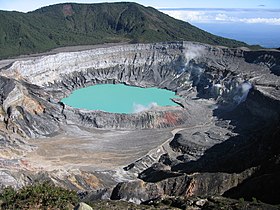Poás Volcano
| Poás Volcano | |
|---|---|

Poás volcano crater
|
|
| Highest point | |
| Elevation | 2,708 m (8,885 ft) 78 |
| Coordinates | 10°12′N 84°12′W / 10.2°N 84.2°WCoordinates: 10°12′N 84°12′W / 10.2°N 84.2°W |
| Geography | |
| Location | Costa Rica |
| Parent range | Cordillera Central |
| Geology | |
| Mountain type | Stratovolcano |
| Last eruption | April 14, 2017 |
| Climbing | |
| Easiest route | Hike |
The Poás Volcano, (Spanish: Volcán Poás), is an active 2,708-metre (8,885 ft) stratovolcano in central Costa Rica. It has erupted 40 times since 1828, including April, 2017 when visitors and residents were evacuated. The volcano is located within the Poás Volcano National Park.
There are two crater lakes near the summit. The northern lake is known as the Laguna Caliente ("hot lagoon") and is located at a height of 2,300 m in a crater approximately 1.7 km wide and 290–300 m deep. It is one of the world's most acidic lakes. The acidity varies after rain and changes in volcanic activity, sometimes reaching a pH of almost 0; consequently, it supports little or no aquatic life. The bottom of this lake is covered with a layer of liquid sulfur. Acid gases create acid rain and acid fog, causing damage to surrounding ecosystems and often irritation of eyes and lungs.
Lake Botos, the southern lake, fills an inactive crater, which last erupted in 7500 BC. It is cold and clear, and is surrounded by a cloud forest within the National Park boundaries.
On May 17, 1953, an eruption occurred that started a cycle that lasted until 1956. At least two people were reported missing.
Poás was near the epicenter of a 6.1-magnitude earthquake in January 2009 that killed at least forty people and affected Fraijanes, Vara Blanca, Cinchona (the most affected area), the capital San José, and the Central Valley region of Costa Rica.
There was also eruptive activity in 2009 involving minor phreatic eruptions and landslides within the northern active crater. Poás eruptions often include geyser-like ejections of crater-lake water.
On February 25, 2014, a webcam from the Volcanological and Seismological Observatory of Costa Rica (OVSICORI) captured the moment a dark cloud exploded about 1,000 feet in the air from a massive crater of the Poás Volcano. This volcano remains active today. Poás is one of 9 volcanoes currently monitored by the Deep Earth Carbon Degassing Project. The project is collecting data on the carbon dioxide and sulfur dioxide emission rates from subaerial volcanoes.
...
Wikipedia
